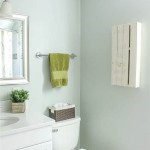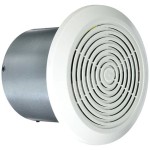Understanding and Preventing Mold Growth on Bathroom Ceilings with Mold-Resistant Paint
Bathrooms, by their very nature, are prone to high humidity and moisture levels. Showers, baths, and even the simple act of washing hands contribute to an environment conducive to mold growth. The ceiling, often overlooked in routine cleaning, becomes a prime target due to rising warm, moist air condensing on its surface. Mold growth not only poses a health hazard, particularly for individuals with allergies or respiratory sensitivities, but also detracts from the aesthetic appeal of the bathroom. Selecting the right type of paint, specifically mold-resistant bathroom ceiling paint, is a proactive step in preventing and mitigating this common problem.
Mold requires three key ingredients to thrive: moisture, nutrients, and a suitable temperature. Bathrooms consistently provide the first two, while typical room temperatures generally satisfy the third. Organic matter, such as dust, soap scum, and even remnants of previous paint jobs, act as nutrients for mold spores. Regular cleaning and proper ventilation can help minimize these factors, but selecting a paint formulated to resist mold growth offers an additional layer of protection.
Key Point 1: Understanding Mold-Resistant Paint Formulations
Mold-resistant paints are not simply regular paints with a marketing gimmick. They differ fundamentally in their composition and properties. These paints typically incorporate additives called biocides, specifically fungicides and mildewcides. These agents inhibit the growth of mold and mildew on the paint film. The efficacy of these biocides depends on their concentration within the paint formulation and their ability to leach out slowly over time, providing long-term protection.
The paint's resin also plays a crucial role. Acrylic-based paints are generally preferred for bathrooms due to their superior water resistance and durability compared to alkyd-based paints. Acrylic resins form a tighter, less porous film, making it harder for moisture to penetrate and for mold to take hold. Furthermore, some acrylic paints are formulated with enhanced stain resistance, further contributing to a cleaner and more hygienic surface.
It's important to note that "mold-resistant" does not mean "mold-proof." No paint can completely eliminate the possibility of mold growth under extreme conditions. Mold-resistant paints primarily inhibit the growth of mold on the paint film itself. Underlying moisture issues, such as leaks or inadequate ventilation, can still lead to mold growth behind the paint or on other surfaces. Therefore, addressing the root cause of moisture problems is crucial for long-term mold prevention.
When selecting mold-resistant paint, it's advisable to look for products specifically labeled for bathroom use. These paints are typically formulated with higher concentrations of biocides and enhanced water resistance to withstand the harsh conditions present in bathrooms. Reading the product label and technical data sheet will provide valuable information about the paint's composition, performance characteristics, and application instructions.
The effectiveness of mold-resistant paint can also be influenced by the surface preparation. Applying paint over existing mold growth will not solve the problem. Before painting, it's essential to thoroughly clean the surface with a mold-killing solution and remove any existing mold. Sanding the surface may also be necessary to create a smooth, even surface for the new paint to adhere to. Proper surface preparation is crucial for ensuring the paint's long-term performance and preventing future mold problems.
Key Point 2: Proper Surface Preparation and Application Techniques
The longevity and efficacy of mold-resistant paint largely depend on proper surface preparation and application techniques. Neglecting these steps can significantly reduce the paint's ability to resist mold growth and may even lead to premature failure of the paint film.
The initial step involved in surface preparation is thorough cleaning. This involves removing any existing mold, dirt, dust, and soap scum from the ceiling. A solution of diluted bleach (one part bleach to three parts water) can be effective for killing mold, but it's crucial to wear appropriate safety gear, including gloves, eye protection, and a respirator, to avoid contact with bleach and its fumes. After applying the bleach solution, scrub the surface thoroughly with a stiff brush to remove any remaining mold and residue. Rinse the surface with clean water and allow it to dry completely before proceeding.
If the ceiling has been previously painted, it may be necessary to sand the surface to create a better bonding surface for the new paint. Use a fine-grit sandpaper to lightly sand the entire ceiling, paying particular attention to any areas with imperfections or peeling paint. After sanding, remove any dust with a tack cloth or damp sponge. This step is crucial for ensuring that the new paint adheres properly and forms a smooth, even finish.
Applying a primer is highly recommended, especially if the ceiling has been previously painted or if it is made of porous material such as drywall. A primer helps to seal the surface, improve paint adhesion, and create a uniform base for the topcoat. Choose a primer that is specifically designed for use in bathrooms and that is compatible with the mold-resistant paint being used. Apply the primer according to the manufacturer's instructions, ensuring that it is evenly distributed and that all areas of the ceiling are covered.
When applying the mold-resistant paint, use high-quality brushes and rollers. A high-quality brush will provide better coverage and a smoother finish, while a high-quality roller will allow for efficient application over large areas. Apply the paint in thin, even coats, following the manufacturer's instructions regarding drying time between coats. Applying multiple thin coats is generally better than applying one thick coat, as it allows the paint to dry properly and prevents runs and drips. Typically, two coats of mold-resistant paint are recommended for optimal protection.
Adequate ventilation is crucial during the painting process. Open windows and doors to allow fresh air to circulate, and consider using a fan to help dry the paint faster. Avoid painting in humid conditions, as this can slow down the drying process and increase the risk of mold growth. After painting, allow the paint to cure completely before exposing the bathroom to moisture. This typically takes several days, depending on the paint formulation and environmental conditions.
Key Point 3: Maintaining a Mold-Resistant Bathroom Environment
While mold-resistant paint provides enhanced protection, it is not a substitute for good bathroom hygiene and proper ventilation. Maintaining a mold-resistant bathroom environment requires a multi-faceted approach that includes regular cleaning, effective ventilation, and prompt attention to moisture issues.
Regular cleaning is essential for preventing mold growth. Wipe down bathroom surfaces, including the ceiling, walls, and shower, with a mild detergent and water solution on a weekly basis. Pay particular attention to areas that are prone to moisture, such as the shower and sink. Regularly clean shower curtains and shower doors to remove soap scum and mildew. Also, clean bathroom mats and rugs regularly, as they can trap moisture and provide a breeding ground for mold.
Proper ventilation is crucial for removing moisture from the bathroom after showering or bathing. Use the bathroom exhaust fan during and after showering or bathing for at least 20 minutes to remove excess moisture from the air. If the bathroom does not have an exhaust fan, consider installing one. Alternatively, open a window to allow fresh air to circulate. Ensuring adequate ventilation helps to prevent moisture from condensing on the ceiling and walls, reducing the risk of mold growth.
Promptly address any moisture issues, such as leaks or condensation problems. Repair leaky faucets and pipes immediately to prevent water from accumulating and creating a breeding ground for mold. If condensation is a persistent problem, consider improving the insulation in the bathroom to reduce temperature fluctuations. You can also use a dehumidifier to remove excess moisture from the air.
Inspect the bathroom ceiling regularly for signs of mold growth. Look for dark spots, discoloration, or a musty odor. If mold is detected, clean the affected area immediately with a mold-killing solution. If the mold infestation is extensive, it may be necessary to hire a professional mold remediation company.
Consider using mold-resistant caulk and sealant around the bathtub, shower, and sink to prevent water from seeping into cracks and crevices. Regularly inspect the caulk and sealant for signs of damage or deterioration and replace it as needed. Mold-resistant grout can also be used to prevent mold growth between tiles.
By combining the use of mold-resistant bathroom ceiling paint with regular cleaning, proper ventilation, and prompt attention to moisture issues, individuals can significantly reduce the risk of mold growth and maintain a healthy and hygienic bathroom environment. This proactive approach not only protects the property value but also safeguards the health and well-being of occupants.

Best Paint For Steamy Bathroom Ceiling Eco Inc

Ceiling Paint For Bathroom Prestige Painting Gta

Detecting And Preventing Mold Growth On Your Bathroom Ceiling Trusscore

Zinsser Perma White 1 Gal Mold Mildew Proof Satin Interior Paint 2 Pack 02711 The Home

Mildew Resistant Ceiling Paint At Com

6 Steps To Get Rid Of Mold On The Bathroom Ceiling Redfish Inspections

How I Prevent Mold On Bathroom Ceilings Lopco Contracting Ri

Guide To The Best Mold Resistant Paints Precision Painting Plus

Guide To The Best Mold Resistant Paints Precision Painting Plus

Odour Less Anti Mould Ceiling White Nippon Paint Singapore
See Also







